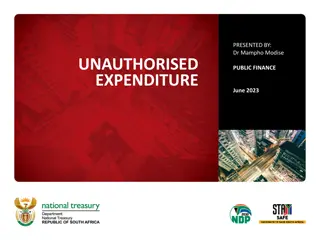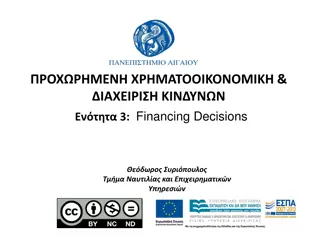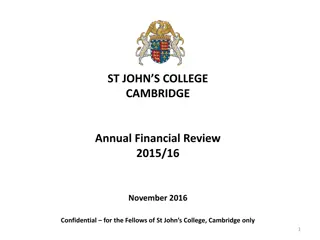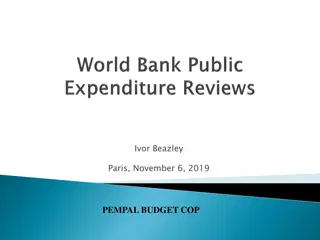Understanding Capital Expenditure Decisions in Financial Management
Capital expenditure decisions involve evaluating long-term investment projects in assets like buildings and machinery to maximize shareholder wealth. This process is crucial for businesses as it helps in increasing output, reducing costs, and providing contemporary goods to meet customer demands, ultimately determining the profitability and survival in the competitive market.
- Capital Expenditure
- Financial Management
- Investment Decisions
- Shareholder Wealth
- Business Profitability
Download Presentation

Please find below an Image/Link to download the presentation.
The content on the website is provided AS IS for your information and personal use only. It may not be sold, licensed, or shared on other websites without obtaining consent from the author. Download presentation by click this link. If you encounter any issues during the download, it is possible that the publisher has removed the file from their server.
E N D
Presentation Transcript
Financial Management 6thSemester Unit-6 Capital Expenditure Decisions-I Prepared by RAJA PAUL
Capital Expenditure Decisions-I Concept and Meaning: Capital-Expenditure decisions or Capital Budgeting may be defined as the decision-making process by which firms evaluate the purchase of major fixed assets, including building, machinery equipment etc., which are not meant for sale. Therefore, it is the process of making investment decisions in capital expenditure. In other words, it deals exclusively with major investment proposal which are essentially long term projects, the benefit of which are expected to be received over a period of time longer than one year. Apart from the long-term investment proposals, capital budgeting is also concerned with the firm s scarce financial resources among the available market opportunities with some degree of risk and uncertainty. Nature of capital budgeting: Capital expenditure decisions involve acquisition of assets that have a long life span and which provide benefits spread over a long period of time. Substantial Investments: Capital expenditure decisions involve large amounts of funds. Such decisions have its effect over a long span of time. Irreversible Decision: Capital expenditure decisions once approved represent long term investments that cannot be reversed or withdrawn any time. Withdrawal or reversal of such decisions may lead to considerable financial losses to the firm. Estimation of Future Cash Inflows: Preparation of capital expenditure budget involves forecasting of cash inflows over several years for evaluating the profitability of projects. Maximization of Shareholder s Wealth: It helps protect the interest of the shareholders as well as of the firm because it avoids over investment and under-investment in fixed assets. Purpose of Capital Expenditure Decisions: The capital expenditure decision or capital budgeting is a process that plans to ascertain the long- term investments of the firm. The main purpose of capital budgeting is to recognize as well as prioritize capital investments on the basis of maximum returns to the business. It is also considered as a managerial tool required for efficient management of collected capital of the firm. Objectives of Capital Expenditure Decisions: Financing decisions are one of the most crucial and critical decisions of a firm as they have a significant impact on the profitability of the firm. There are number of objectives of capital expenditure decisions, some of which are: Increasing Output: Output may be increased by utilizing existing facility or through expansion by installing new plant and machinery. Cost Reduction: The existence of a firm depends on profitability, which in turn depends on the production of goods or services at a reasonable price. This is possible if over/under-investment in fixed assets is avoided. Providing Contemporary Goods: Consumer tastes change every day. To satisfy the new demands from customers, either proper utilization of existing facility or installation of the latest machinery is necessary which is not possible without proper capital expenditure decision.
Importance of Capital Expenditure decision: Capital budgeting is important, because it creates accountability and mediocrity. Any business that wants to invest its resources in a project without understanding risk and returns, it will be considered irresponsible by its owners or shareholders. Except this, if a business has no way to measure the effectiveness of its investment decisions, then it is likely that the business will have less chance of survival in the competitive market. Any Businesses are present to earn profits. The capital budgeting process is a measurable way for businesses to determine the long term economic and financial profitability of any investment project. Capital budgeting is also important for a business. Importance of Capital Expenditure decision: Construction of Decision: When a capital budgeting process occurs, a company is then able to make a set of decision rules, which can classify that which projects are acceptable and which projects are unacceptable. The result is a more efficient business that is better to quickly find out whether to move ahead with a project. Or stop early in the process, saving the company both time and money. Difficult to make decision in Capital budgeting: Capital budgeting decisions for management is a difficult and complicated exercise. These decisions require all the assessments of future events which are uncertain. It is actually the marathon job to accurately estimate the benefits and costs in the future, due to uncertainties of economic, political, social and technical factors. Risk and uncertainty in Capital budgeting: The capital budget decision is surrounded by a large number of uncertainties. Investment is in present or in the future. The future is uncertain and full of risks. The longer your project, you have the risk, and the uncertainty may be high. Estimates about cost, revenue and profits can t be accurate. Maximize the worth of Equity Shareholders: The value of equity shareholders increases with the acquisition of fixed assets through the capital budget. Instead of investing more than a fixed capital budget there is an optimum investment in the fixed assets is done. Management selects only the most profitable capital project. Those can have a very high value. In this way, capital budget maximizes the value of equity shareholders. Facilitate the transfer of information: Provide facility of transfer of information from that time, when a project starts in the form of an idea for the time. And that project is accepted or rejected. Then, many decisions have to be made at various levels of the Authority. The capital budgeting process facilitates to the appropriate decision makers the transfer of information within a company. Estimate and forecast future cash flows: Estimate and forecasts of future cash flows make time for businesses with time. Capital budgets enable the authorities to take the possible project and estimate its future cash flow, which then helps in determining whether such a project should accept. Monitoring and Control of Expenditures: According to a budget definition, monitoring and control of expenditure identify the expenditure and R & D for an investment project. Since a good project may get spoiled, if the expenditure has not meticulously controlled or monitored. Then this step is an important benefit of the capital budget process. Long-term impact on profitability: Capital expenditure has a great impact on the commercial profitability in the long run, if the capital budget was spent properly. Then the profitability of the firm is likely to increase. The complaint of investment decisions: Generally, long-term investment proposals are more complex in nature. Apart from this, the purchase of fixed assets is a continuous process. Therefore, management should understand the complexities associated with each project. Long-term Implications of Capital Budgeting: The decision of the capital budget has a long-term impact and essentially influences the cost structure and development of the company s future. A wrong decision can prove disastrous for the firm s long-term survival. On the other hand, the lack of investment in the asset will affect the firm s competitive position. So capital budgeting decisions determine the company s future destiny.
Features of Capital Budgeting: Capital budgeting is the process of identifying, analyzing and selecting of profitable investment proposals from which returns or cash inflows are expected to realize over a series of years beyond the current year. Capital budgeting decisions have few extinguishing features that are stated below: Current funds are invested with the expectation of realizing future benefits. The future benefits will occur to the firm over a series of years and not in one year alone. Expenditure and benefits of an investment proposal should be measured in terms of cash flows and not in terms of accounting profit. Decision under capital budgeting is subject to high degree of business risk as it depends on such factors that are variable in nature. Selection of profitable investment proposal on the basis of capital budgeting technique helps to satisfy the prime goal of the firm which may be shareholders wealth maximization, profit maximization or maximization of the value of the firm. The time gap between the initial outlays and the first inflow of cash may often being longer. Capital expenditure is incurred at a particular point of time but the benefit of such expenditure may realize over a series of years in the future. Capital budgeting is futuristic in nature. CAPITAL BUDGETING PROCESS: Project identification and generation: The first step towards capital budgeting is to generate a proposal for investments. There could be various reasons for taking up investments in a business. It could be addition of a new product line or expanding the existing one. It could be a proposal to either increase the production or reduce the costs of outputs. Project Screening and Evaluation: This step mainly involves selecting all correct criteria s to judge the desirability of a proposal. This has to match the objective of the firm to maximize its market value. The tool of time value of money comes handy in this step. Also the estimation of the benefits and the costs needs to be done. The total cash inflow and outflow along with the uncertainties and risks associated with the proposal has to be analyzed thoroughly and appropriate provisioning has to be done for the same. Project Selection: There is no such defined method for the selection of a proposal for investments as different businesses have different requirements. That is why, the approval of an investment proposal is done based on the selection criteria and screening process which is defined for every firm keeping in mind the objectives of the investment being undertaken. Once the proposal has been finalized, the different alternatives for raising or acquiring funds have to be explored by the finance team. This is called preparing the capital budget. The average cost of funds has to be reduced. A detailed procedure for periodical reports and tracking the project for the lifetime needs to be streamlined in the initial phase itself. The final approvals are based on profitability, Economic constituents, viability and market conditions. Implementation: Money is spent and thus proposal is implemented. The different responsibilities like implementing the proposals, completion of the project within the requisite time period and reduction of cost are allotted. The management then takes up the task of monitoring and containing the implementation of the proposals. Performance review: The final stage of capital budgeting involves comparison of actual results with the standard ones. The unfavorable results are identified and removing the various difficulties of the projects helps for future selection and execution of the proposals. FACTORS AFFECTING CAPITAL BUDGETING: Availability of funds Structure of capital Management decisions Accounting methods Taxation policy Earnings Working capital Capital return Need of the project Government policy
Accounting or Average Rate of Return (ARR): ARR is based on the accounting concept of return on investment. This may be defined as the annualized after tax profit expressed as percentage of average investment or net investment is calculated as: Where, Decision rule: If ARR Predetermined or industry rate of return, Project should be accepted. In case of mutually exclusive projects, project with highest ARR is to be accepted. Merits: Easy to calculate Easy to understand Goes with accounting concept of profitability Accounting profits are easily available Demerits: Ignores time value of money Accounting profits rather than cash-flows are taken into account May be affected due to accounting policy Fails to distinguish between two projects having different life Does not recognize size of investment- can t compare two projects of different initial investment.
Payback Period (PBP): PBP is the length of time required to recover initial cost of investment. It is the break-even point of the project. It refers to the time period within which net cash flows recover the initial cash outflow. It can be calculated as follows: When net annual cash flows are equal, Advantages: Simple and easy in concept and also in application Gives an indication of liquidity In broader sense, it deals with risk also, as lesser the future the lesser is the risk Helpful in capital rationing also Takes cash flows into account Limitations: Does not consider time value of money Ignores cash flows after the payback period Also ignores salvage value and total economic life of the project It is more a method of capital recovery rather than a measure of profitability Fails as a criterion when there is no or little initial investment Payback Profitability: The net cash flows remaining after the recovery of initial investment on a project is termed as Payback Profitability. Payback Profitability = Annual Cash Inflows (Estimated life PBP) Payback Reciprocal:
THANK YOU FOR WATCHING MY PRESENTATION

























